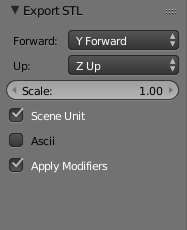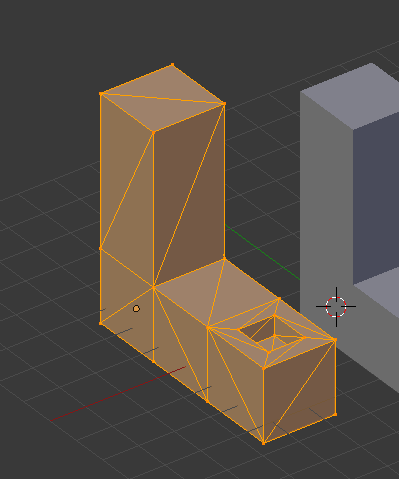Exporting to STL¶
Blender can export to STL, which is a fairly standard file format for 3D printing. This section demonstrates the changes that occur to a mesh when exporting and re-importing an STL
Exercise: Exporting an STL
- Either save your existing work as a .blend file () or load this example:
L-centered.blend. - Select the object to export.
- Check the Scene Unit checkbox. This stores the units in the STL file.

- Select a filename and location lick the button
- Import the just-exported STL: ().
- The new object came in right on top of the existing one, so select it and move it out of the way.
- Switch to Edit Mode after selecting the original and the newly imported version: what’s different?
Importing an STL¶
Be careful: when opening someone else’s STL, often we don’t know ahead of time if units were stored in the STL file. If you import an object and it’s either huge or so small it looks like nothing happened, you will need to be more careful about units. If units were not stored in the STL, Blender assumes meters. If units are not set in Blender but they are set in the STL, Blender assumes its “None” units are meters. Here is a summary of how Blender behaves when importing STL files with or without units:
Note
| Blender units | STL units | Imported object size |
|---|---|---|
| None | None | OK |
| millimeters | millimeters | OK |
| meters | meters | OK |
| None | millmeters | Very small |
| millimeters | None | Huge |
| meters | None | OK |
If the size of the imported object seems wrong, try setting or unsetting Blender’s units
Many algorithms for working with 3D objects operate on triangles – in particular those used for slicing models for printing. The STL format works in triangles (tris), but we were modeling in quads. Exporting an STL implicitly triangulated all faces.
Sometimes it is useful to convert from tris back to quads, since they’re easier to think about, manipulate, and calculate coordinates for precision modeling.
Exercise: tris to quads
- In Edit Mode, select all faces
- Convert tris to quads (
Alt-J, orSpaceand search for “tris to quads”)
- Note that some faces (the inset ones) were not converted to quads – the
algorithm is not perfect. To fix this, we could delete the edges and use
Fto re-fill the faces as quads. We might have to do this if we imported someone else’s STL. In practice, it’s better to save the original .blend file for modifiying.
Examples¶
Example “L” shape¶
- units stored in the STL (
L-centered-units.stl) - units not stored in the STL (
L-centered-no-units.stl) - blender file (
L-centered.blend)
Example instrument mount¶
- Started from Simple Beaker Clamp on the NIH 3D Print Exchange (
MainArm_0.stl) - Modified instrument mount Blender file (
instrument-mount.blend) - Modified instrument mount STL file (
instrument-mount.stl)

